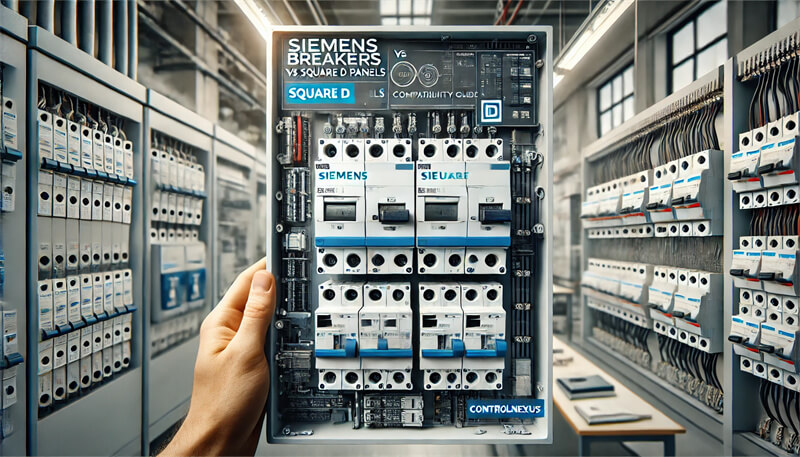Key Takeaways Table
| Question | Answer |
|---|---|
| Are Siemens breakers compatible with Square D panels? | Siemens breakers are generally not compatible with Square D panels. |
| What are the risks of using incompatible breakers? | Potential electrical hazards, voided warranties, and non-compliance with code. |
| Can I install a Siemens breaker in a Square D panel? | It is not recommended unless explicitly stated by the manufacturer. |
| What safety precautions should I take? | Always consult a professional electrician and use UL-listed breakers. |
| Where can I find compatibility information? | Refer to manufacturer guides and consult with an expert for specific cases. |
Introduction
When dealing with electrical systems, ensuring the compatibility of circuit breakers with your panel is crucial. Incompatibility can lead to serious issues, including electrical hazards, voided warranties, and potential non-compliance with local codes. This article will explore whether Siemens breakers are compatible with Square D panels, providing the guidance you need to make informed decisions.
ControlNexus, established in 2013, is a trusted provider of Siemens PLCs, HMIs, and Inverters. Our expertise in Siemens products ensures that you get reliable and efficient solutions for your automation needs.
Understanding Circuit Breaker Compatibility
Breaker Types
Circuit breakers are essential components in electrical panels, designed to protect circuits from overloads and short circuits. There are various types of breakers, including single-pole and double-pole breakers, each serving different purposes in your electrical system. However, not all breakers are created equal, and compatibility with your electrical panel is a key consideration.
Brand Differences
One of the most common questions is whether breakers from different brands can be interchanged. Specifically, are Siemens breakers compatible with Square D panels? The short answer is that Siemens breakers are generally not compatible with Square D panels. This incompatibility arises from differences in design, mounting methods, and electrical characteristics. It's essential to use breakers that are explicitly listed as compatible by the panel manufacturer.
Electrical Panel Requirements
Every electrical panel is designed to work with specific breakers. These requirements are based on the panel's design, including its bus bar configuration and mounting style. Using a breaker that does not meet these requirements can result in poor performance, increased safety risks, and potential violations of local electrical codes.
Compatibility of Siemens Breakers with Square D Panels
Technical Comparison
When comparing Siemens and Square D breakers, several factors come into play:
- Design and Mounting: Siemens and Square D breakers often use different mounting systems. Siemens breakers typically have a specific way of attaching to the panel's bus bars, which might not align with Square D's design.
- Electrical Characteristics: The electrical specifications, such as interrupting ratings and voltage requirements, can differ significantly between brands.
- Manufacturer Guidelines: Always refer to the manufacturer's guidelines for compatibility. Siemens breakers are designed to work with Siemens panels, and deviating from this can lead to unsafe conditions.
Compatibility Chart
While it's crucial to consult your panel's documentation or a professional, the following general rule applies: Siemens breakers are not recommended for use in Square D panels unless explicitly stated by the manufacturer. Here's a quick reference:
- Square D Panels: Use only Square D breakers or other breakers specifically listed by the manufacturer as compatible.
- Siemens Panels: Use Siemens breakers, which are designed to fit and function correctly within Siemens panels.
Common Issues with Incompatible Breakers
Using incompatible breakers can lead to several problems, including:
- Electrical Hazards: Incompatible breakers may not trip properly, leading to overheating or even electrical fires.
- Voided Warranties: Installing a non-compatible breaker can void the warranty on your electrical panel.
- Non-Compliance with Code: Electrical codes often require the use of listed and labeled breakers, meaning that they have been tested and approved for use with a specific panel.
Installation Guidelines and Safety Tips
Step-by-Step Installation Guide
If you are installing a breaker in your panel, it's essential to follow a step-by-step approach:
- Turn Off the Power: Always start by turning off the power at the main breaker to avoid electrical shock.
- Verify Compatibility: Double-check that the breaker is compatible with your panel by consulting the panel's documentation.
- Install the Breaker: Follow the manufacturer's instructions for mounting the breaker in the panel.
- Connect the Wires: Ensure all connections are tight and secure, following the correct wiring practices.
- Test the Breaker: After installation, test the breaker to ensure it operates correctly.
Safety Precautions
- Consult a Professional: If you're unsure about any part of the installation, consult a licensed electrician.
- Use UL-Listed Breakers: Only use breakers that are UL-listed for your specific panel. This ensures they have been tested for safety and compliance.
- Follow Local Codes: Adhere to local electrical codes, which may have specific requirements for breaker installation.
For more information on breaker compatibility, check out our detailed guide to compatible breakers for Siemens panels.
Frequently Asked Questions (FAQs)
Can Siemens Breakers Fit in a Square D Panel?
This is a common question among homeowners and professionals alike. Siemens breakers are generally not designed to fit in Square D panels due to differences in their physical design, mounting systems, and electrical characteristics. It's essential to use breakers that are specifically listed as compatible by the panel manufacturer to ensure safety and proper operation.
What Are the Risks of Using Non-Compatible Breakers?
Using breakers that are not compatible with your panel can lead to several serious risks:
- Electrical Hazards: Incompatible breakers may not properly protect against electrical faults, increasing the risk of fire or equipment damage.
- Voided Warranties: Many manufacturers will void the warranty on your electrical panel if non-compatible breakers are used.
- Code Violations: Electrical codes require the use of breakers that are listed and labeled for use with a specific panel. Using non-compatible breakers may result in non-compliance, which can be problematic during inspections or when selling a property.
How Can I Ensure I’m Using the Right Breaker?
The best way to ensure you are using the correct breaker is to:
- Consult the Panel’s Documentation: The manufacturer's guide will specify which breakers are compatible with your panel.
- Use UL-Listed Breakers: Always use UL-listed breakers that are tested and approved for your specific panel.
- Consult with a Professional: If in doubt, consult with a licensed electrician who can provide expert advice on breaker compatibility.
Expert Advice and Recommendations
Consulting with an Electrician
When it comes to electrical work, safety should always be the top priority. If you're unsure about the compatibility of a breaker or how to properly install it, it's wise to consult with a licensed electrician. Professional electricians have the experience and knowledge to ensure that your electrical system is safe and compliant with all local codes.
Specific Model Recommendations
If you are looking for a Siemens breaker that might be compatible with a Square D panel, it’s essential to refer to the compatibility charts provided by the manufacturer. However, in most cases, it's recommended to use Siemens breakers only with Siemens panels to avoid potential issues. Always double-check with the manufacturer or an expert to ensure you are making the right choice.
For further details on Siemens products, explore our offerings of Siemens PLCs, Siemens HMIs, and Siemens Inverters.
Conclusion
Summary of Key Points
In conclusion, ensuring the compatibility of your circuit breakers with your electrical panel is critical to the safety and efficiency of your electrical system. Siemens breakers are generally not compatible with Square D panels, and using non-compatible breakers can lead to significant risks, including electrical hazards, voided warranties, and code violations.
Before purchasing or installing a circuit breaker, always consult your panel’s documentation and consider seeking the advice of a professional electrician. By doing so, you can ensure that your electrical system remains safe, efficient, and compliant with all relevant codes.
For more in-depth guides and expert advice on Siemens products, visit our website’s blog or contact our team at ControlNexus for assistance.
Additional Resources
- Comprehensive Guide to Compatible Breakers for Siemens Panels
- How to Safely Open and Inspect a Siemens Electrical Panel
- Choosing the Right Breaker for Your Siemens Service Panel
Explore these articles for more detailed information on Siemens electrical systems and how to maintain them safely and efficiently.



